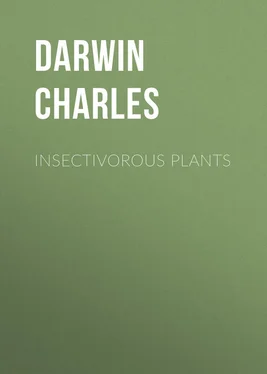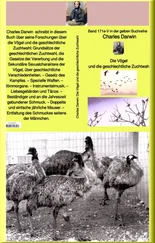Charles Darwin - Insectivorous Plants
Здесь есть возможность читать онлайн «Charles Darwin - Insectivorous Plants» — ознакомительный отрывок электронной книги совершенно бесплатно, а после прочтения отрывка купить полную версию. В некоторых случаях можно слушать аудио, скачать через торрент в формате fb2 и присутствует краткое содержание. Жанр: foreign_antique, foreign_prose, на английском языке. Описание произведения, (предисловие) а так же отзывы посетителей доступны на портале библиотеки ЛибКат.
- Название:Insectivorous Plants
- Автор:
- Жанр:
- Год:неизвестен
- ISBN:нет данных
- Рейтинг книги:5 / 5. Голосов: 1
-
Избранное:Добавить в избранное
- Отзывы:
-
Ваша оценка:
- 100
- 1
- 2
- 3
- 4
- 5
Insectivorous Plants: краткое содержание, описание и аннотация
Предлагаем к чтению аннотацию, описание, краткое содержание или предисловие (зависит от того, что написал сам автор книги «Insectivorous Plants»). Если вы не нашли необходимую информацию о книге — напишите в комментариях, мы постараемся отыскать её.
Insectivorous Plants — читать онлайн ознакомительный отрывок
Ниже представлен текст книги, разбитый по страницам. Система сохранения места последней прочитанной страницы, позволяет с удобством читать онлайн бесплатно книгу «Insectivorous Plants», без необходимости каждый раз заново искать на чём Вы остановились. Поставьте закладку, и сможете в любой момент перейти на страницу, на которой закончили чтение.
Интервал:
Закладка:
The secretion seems to possess, like the gastric juice of the higher animals, some antiseptic power. During very warm weather I placed close together two equal-sized bits of raw meat, one on a leaf of the Drosera, and the other surrounded by wet moss. They were thus left for 48 hrs., and then examined. The bit on the moss swarmed with infusoria, and was so much decayed that the transverse striae on the muscular fibres could no longer be clearly distinguished; whilst the bit on the leaf, which was bathed by the secretion, was free from infusoria, and its striae were perfectly distinct in the central and undissolved portion. In like manner small cubes of albumen and cheese placed on wet moss became threaded with filaments of mould, and had their surfaces slightly discoloured and disintegrated; whilst those on the leaves of Drosera remained clean, the albumen being changed into transparent fluid.
As soon as tentacles, which have remained closely inflected during several days over an object, begin to re-expand, their glands secrete less freely, or cease to secrete, and are left dry. In this state they are covered with a film of whitish, semi-fibrous matter, which was held in solution by the secretion. The drying of the glands during the act of re-expansion is of some little service to the plant; for I have often observed that objects adhering to the leaves could then be blown away by a breath of air; the leaves being thus left unencumbered and free for future action. Nevertheless, it often happens that all the glands do not become completely dry; and in this case delicate objects, such as fragile insects, are sometimes torn by the re-expansion of the tentacles into fragments, which remain scattered all over the leaf. After the re-expansion is complete, the glands quickly begin to re-secrete, and as soon as full-sized drops are formed, the tentacles are ready to clasp a new object.
When an insect alights on the central disc, it is instantly entangled by the viscid secretion, and the surrounding tentacles after a time begin to bend, and ultimately clasp it on all sides. Insects are generally killed, according to Dr. Nitschke, in about a quarter of an hour, owing to their tracheae being closed by the secretion. If an insect adheres to only a few of the glands of the exterior tentacles, these soon become inflected and carry their prey to the tentacles next succeeding them inwards; these then bend inwards, and so onwards; until the insect is ultimately carried by a curious sort of rolling movement to the centre of the leaf. Then, after an interval, the tentacles on all sides become inflected and bathe their prey with their secretion, in the same manner as if the insect had first alighted on the central disc. It is surprising how minute an insect suffices to cause this action: for instance, I have seen one of the smallest species of gnats (Culex), which had just settled with its excessively delicate feet on the glands of the outermost tentacles, and these were already beginning to curve inwards, though not a single gland had as yet touched the body of the insect. Had I not interfered, this minute gnat would assuredly have been carried to the centre of the leaf and been securely clasped on all sides. We shall hereafter see what excessively small doses of certain organic fluids and saline solutions cause strongly marked inflection.
Whether insects alight on the leaves by mere chance, as a resting place, or are attracted by the odour of the secretion, I know not. I suspect from the number of insects caught by the English species of Drosera, and from what I have observed with some exotic species kept in my greenhouse, that the odour is attractive. In this latter case the leaves may be compared with a baited trap; in the former case with a trap laid in a run frequented by game, but without any bait.
That the glands possess the power of absorption, is shown by their almost instantaneously becoming dark-coloured when given a minute quantity of carbonate of ammonia; the change of colour being chiefly or exclusively due to the rapid aggregation of their contents. When certain other fluids are added, they become pale-coloured. Their power of absorption is, however, best shown by the widely different results which follow, from placing drops of various nitrogenous and non-nitrogenous fluids of the same density on the glands of the disc, or on a single marginal gland; and likewise by the very different lengths of time during which the tentacles remain inflected over objects, which yield or do not yield soluble nitrogenous matter. This same conclusion might indeed have been inferred from the structure and movements of the leaves, which are so admirably adapted for capturing insects.
The absorption of animal matter from captured insects explains how Drosera can flourish in extremely poor peaty soil, – in some cases where nothing but sphagnum moss grows, and mosses depend altogether on the atmosphere for their nourishment. Although the leaves at a hasty glance do not appear green, owing to the purple colour of the tentacles, yet the upper and lower surfaces of the blade, the pedicels of the central tentacles, and the petioles contain chlorophyll, so that, no doubt, the plant obtains and assimilates carbonic acid from the air. Nevertheless, considering the nature of the soil where it grows, the supply of nitrogen would be extremely limited, or quite deficient, unless the plant had the power of obtaining this important element from captured insects. We can thus understand how it is that the roots are so poorly developed. These usually consist of only two or three slightly divided branches, from half to one inch in length, furnished with absorbent hairs. It appears, therefore, that the roots serve only to imbibe water; though, no doubt, they would absorb nutritious matter if present in the soil; for as we shall hereafter see, they absorb a weak solution of carbonate of ammonia. A plant of Drosera, with the edges of its leaves curled inwards, so as to form a temporary stomach, with the glands of the closely inflected tentacles pouring forth their acid secretion, which dissolves animal matter, afterwards to be absorbed, may be said to feed like an animal. But, differently from an animal, it drinks by means of its roots; and it must drink largely, so as to retain many drops of viscid fluid round the glands, sometimes as many as 260, exposed during the whole day to a glaring sun.
CHAPTER II
Inflection of the exterior tentacles owing to the glands of the disc being excited by repeated touches, or by objects left in contact with them – Difference in the action of bodies yielding and not yielding soluble nitrogenous matter – Inflection of the exterior tentacles directly caused by objects left in contact with their glands – Periods of commencing inflection and of subsequent re-expansion – Extreme minuteness of the particles causing inflection – Action under water – Inflection of the exterior tentacles when their glands are excited by repeated touches – Falling drops of water do not cause inflection.
I WILL give in this and the following chapters some of the many experiments made, which best illustrate the manner and rate of movement of the tentacles, when excited in various ways. The glands alone in all ordinary cases are susceptible to excitement. When excited, they do not themselves move or change form, but transmit a motor impulse to the bending part of their own and adjoining tentacles, and are thus carried towards the centre of the leaf. Strictly speaking, the glands ought to be called irritable, as the term sensitive generally implies consciousness; but no one supposes that the Sensitive-plant is conscious, and as I have found the term convenient, I shall use it without scruple. I will commence with the movements of the exterior tentacles, when indirectly excited by stimulants applied to the glands of the short tentacles on the disc. The exterior tentacles may be said in this case to be indirectly excited, because their own glands are not directly acted on. The stimulus proceeding from the glands of the disc acts on the bending part of the exterior tentacles, near their bases, and does not (as will hereafter be proved) first travel up the pedicels to the glands, to be then reflected back to the bending place. Nevertheless, some influence does travel up to the glands, causing them to secrete more copiously, and the secretion to become acid. This latter fact is, I believe, quite new in the physiology of plants; it has indeed only recently been established that in the animal kingdom an influence can be transmitted along the nerves to glands, modifying their power of secretion, independently of the state of the blood-vessels.
Читать дальшеИнтервал:
Закладка:
Похожие книги на «Insectivorous Plants»
Представляем Вашему вниманию похожие книги на «Insectivorous Plants» списком для выбора. Мы отобрали схожую по названию и смыслу литературу в надежде предоставить читателям больше вариантов отыскать новые, интересные, ещё непрочитанные произведения.
Обсуждение, отзывы о книге «Insectivorous Plants» и просто собственные мнения читателей. Оставьте ваши комментарии, напишите, что Вы думаете о произведении, его смысле или главных героях. Укажите что конкретно понравилось, а что нет, и почему Вы так считаете.












